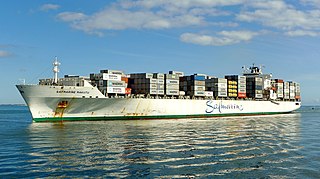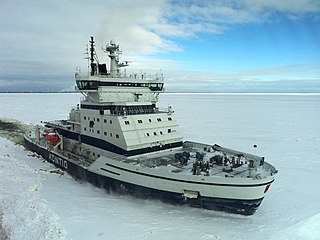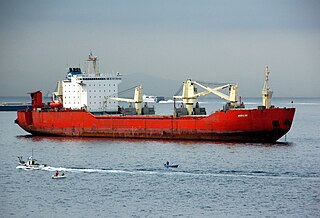
A steamship, often referred to as a steamer, is a type of steam-powered vessel, typically ocean-faring and seaworthy, that is propelled by one or more steam engines that typically move (turn) propellers or paddlewheels. The first steamships came into practical usage during the early 1800s; however, there were exceptions that came before. Steamships usually use the prefix designations of "PS" for paddle steamer or "SS" for screw steamer. As paddle steamers became less common, "SS" is incorrectly assumed by many to stand for "steamship". Ships powered by internal combustion engines use a prefix such as "MV" for motor vessel, so it is not correct to use "SS" for most modern vessels.

A container ship is a cargo ship that carries all of its load in truck-size intermodal containers, in a technique called containerization. Container ships are a common means of commercial intermodal freight transport and now carry most seagoing non-bulk cargo.

Safmarine, short for South African Marine Corporation, and latterly South African Marine Container Lines, was a South African shipping line, established in 1946, which offered freight transport services with cargo liners and container ships. It was bought by Maersk Line in 1999, and was fully integrated into that company in 2020. It also operated passenger vessels and specialised cargo ships.

Emma Mærsk is the first container ship in the E class of eight owned by A.P. Møller – Mærsk A/S. When launched in 2006, she was the largest container ship ever built, and in 2010, she and her seven sister ships were among the longest container ships. Officially, she is able to carry around 11,000 twenty-foot equivalent units (TEU) or 14,770 TEU, depending on definition. In May 2010, her sister ship Ebba Mærsk set a record of 15,011 TEU in Tanger-Med, Tangier.

Marine propulsion is the mechanism or system used to generate thrust to move a watercraft through water. While paddles and sails are still used on some smaller boats, most modern ships are propelled by mechanical systems consisting of an electric motor or internal combustion engine driving a propeller, or less frequently, in pump-jets, an impeller. Marine engineering is the discipline concerned with the engineering design process of marine propulsion systems.

Magadan is a Russian icebreaker and the second vessel in a series of three subarctic icebreakers built at Wärtsilä Helsinki shipyard in Finland in 1982–1983. The vessel's sister ships are Mudyug and Dikson.

Estelle Mærsk is a container ship owned and run by the Mærsk Line. She was, in 2009, the largest ever built by terms of gross tonnage. Estelle Mærsk has a capacity of 11,000 twenty-foot equivalent units (TEU), including around 1,000 40-foot (12 m) reefer containers, though a maximum capacity of 13,500 TEU is claimed. She is identical to the seven other ships in the E class, the first built of which was Emma Maersk.

Kontio is a Finnish state-owned icebreaker. Built by Wärtsilä Helsinki shipyard in 1987 as a replacement for the aging Karhu-class icebreakers, she and her sister ship Otso were the first Finnish post-war icebreaker to be built without bow propellers.
Herakles was a pusher vessel owned by Finnish towing and marine salvage company Alfons Håkans Oy Ab. The ship, originally built as salvage tug Into in 1967, was converted to a pusher in 1991 to be chartered to Rautaruukki Oyj and later ESL Shipping Ltd as the third pusher vessel for the Finnpusku system, a Finnish integrated tug and barge system built in the mid-80s.

SA-15 is the project name for a series of icebreaking multipurpose cargo ships built in Finland for the Soviet Union in the 1980s. The ships, capable of independent operation in all prevailing arctic ice conditions, were the first merchant vessels designed for year-round operations in the Northern Sea Route. For this purpose they have hulls that resemble those of polar icebreakers and propulsion systems capable of withstanding ice loads.

The Triple E class is a family of very large container ships with a capacity of more than 18,000 TEUs, which are owned and operated by Maersk Line.

Eleonora Mærsk is one of the world's largest container ships operated by A. P. Moller and registered to Svendborg, Denmark. It was constructed in 2006 at the Odense Steel Shipyard. There are seven other identical sister ships in the A. P. Moller fleet. Eleonora Mærsk and the other seven ships of the E class are among the biggest ever built.

Evelyn Maersk is owned and operated by the AP Moller-Maersk Group out of Copenhagen, Denmark.

Maersk Line is a Danish international container shipping company and the largest operating subsidiary of Maersk, a Danish business conglomerate. Founded in 1928, it is the world's second largest container shipping company by both fleet size and cargo capacity, offering regular services to 374 ports in 116 countries. In 2019, it employed 83,625 people where 18,398 of which are vessel crew and the other 65,227 are processing and operations personnel in offices and ports. Maersk Line operates over 708 vessels and has a total capacity of about 4.1 million TEU.

Otso is a Finnish state-owned icebreaker. Built by Wärtsilä Helsinki shipyard in 1986 to replace the aging Karhu-class icebreakers, she was the first Finnish post-war icebreaker to be built without bow propellers. Otso has an identical sister ship, Kontio, which was delivered in 1987.

Maersk Mc-Kinney Moller is the first ship of Maersk Line's Triple E class of container vessels. At the time of its entry into service in 2013, it had the largest cargo capacity in twenty-foot equivalent unit (TEU) of any vessel, and was the longest container ship in service worldwide. Constructed for Maersk by Daewoo Shipbuilding & Marine Engineering (DSME) of South Korea, it was launched in February 2013 and began operational service during July 2013. It was named for Mærsk Mc-Kinney Møller, the CEO of Maersk from 1965 to 1993. The ship is the first of a class of 20 identical vessels.

CSCL Globe is a container ship owned and operated by COSCO Shipping and previously, China Shipping Container Lines (CSCL). The first of a class of five ships intended for Asia-Europe trade routes, she was the largest container ship in the world at the time of her launch in November 2014, with a maximum capacity of 19,100 twenty-foot containers.
Magleby Maersk is a Triple E-class container ship and is one of the largest container ships of the world. The vessel was built at the shipyard of Daewoo Shipbuilding & Marine Engineering under yard number 4255. The vessel is owned and operated by the Danish international shipping company Maersk Line, which is the largest operator of container ships in the world. Magleby Maersk has a capacity of 18,270 TEU.

CMA CGM Benjamin Franklin is an Explorer class containership built for CMA CGM. Delivered in November 2015, she is named after Benjamin Franklin, one of the Founding Fathers of the United States. She is one of the largest container cargo vessels, capable of carrying 18,000 TEU.

Maersk Honam is a container ship operated by Maersk Line. The vessel caught fire on 6 March 2018 while sailing in the Arabian Sea. Five members of the crew of 27 were killed, including one rescued crew member who died later from injuries.


















